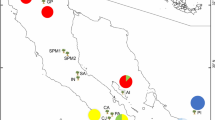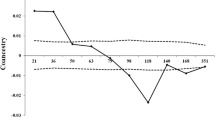Abstract
Knowledge of the effects of farmer practices on population genetic parameters of peach palm (Bactris gasipaes Kunth) is relevant to the improvement and conservation of the palm’s genetic resources. Microsatellite markers were used to assess genetic diversity and population structure of peach palm in swidden-fallow agroforestry systems in northeastern Peru. The study covered eight communities, comprising two study areas 160 km apart – one occupied by indigenous Amerindians and the other by mixed race campesinos. Simultaneous analysis of an ex situ peach palm germplasm collection provided a means to compare population genetic parameters. Farmers who were surveyed on seed selection practices for peach palm reported that an average of only four palms (4.3 for campesino and 1.5 for indigenous populations) were used to provide seed for the establishment of the forest gardens sampled. As expected, inbreeding coefficients observed within communities were relatively high (f = 0.105 − 0.210), however, observed heterozygosities within communities were also high (0.625–0.741). A metapopulation approach was used to describe migration within and among regions, implying a hierarchical structure of gene flow which maintains relatively high levels of genetic diversity. Seed migration was found to occur over longer distances (≤600 km) and at a higher frequency (46% of palms sampled) in the indigenous study area, and a proportionally greater number of alleles was found (49 vs. 43 over three loci) with twice as many private alleles occurring only in the indigenous populations. The farmers’ practice of preserving remnant palms through successive swidden generations may have contributed to the maintenance of alleles by reducing the severity of founder effects. Although the campesino study area exhibited a significant (20% of the variation; p < 0.01) isolation-by-distance relationship across 35 km distance, in general, both study populations had relatively limited genetic structure (θ = 0.012–0.03), which is believed to have resulted from the exchange of seeds over long distances and periods of time.
Similar content being viewed by others
Abbreviations
- FECONA:
-
Federación de Comunidades Nativas del Ampiyacu
- INIA:
-
Instituto Nacional de Investigación Agraria
- CTAB:
-
Cetyltrimethyl ammonium bromide
- PCR:
-
Polymerase chain reaction
- He :
-
Expected heterozygosity
- Ho :
-
Observed heterozygosity
- θ:
-
Analogous to F st
- ρ:
-
Analogous to R st
- f :
-
Similar to F is
- F :
-
Similar to F it
References
Adin A., Weber J.C., Sotelo-Montes C., Vidaurre H., Vosman B. and Smulders M.J.M. (2004). Genetic differentiation and trade among populations of peach palm (Bactris gasipaes Kunth) in the Peruvian Amazon - implications for genetic resource management. Theor. App. Genet. 108: 1564–1573
Balloux F. and Goudet J. (2002). Statistical properties of population differentiation estimators under stepwise mutation in a finite island model. Mol. Ecol. 11: 771–783
Bawa K.S. (1992). Mating systems, genetic differentiation and speciation in tropical rain forest plants. Biotropica 24: 250–255
Bohonak A.J. (2002). IBD (Isolation by Distance): a program for analyses of isolation by distance. J. Heredity 93: 153–154
Brown A.H.D. and Marshall D.R. (1995). A basic sampling strategy: theory and practice. In: Guarino, L., Rasmanaths Rao, V. and Reid, R. (eds) Collecting Plant Genetic Diversity: Technical Guidelines, pp 75–91. CAB International, Wallingford
Chaumeil J.-P. (2001). The blowpipe Indians: variations on the theme of blowpipe and tube among the Yahua Indians of the Peruvian Amazon. In: Rival, L.M. and Whitehead, N.L. (eds) Beyond the Visible and the Material: The Amerindianization of Society in the Work of Peter Rivière, pp 81–100. Oxford Univ. Press, New York
Clement C.R. (1988). Domestication of the pejibaye palm (Bactris gasipaes): past and present. Adv. Econ. Bot. 6: 155–174
Clement C.R. (1989). The potential use of the pejibaye palm in agroforestry systems. Agroforest. Syst. 7: 201–212
Clement C.R. (1990). Regeneração natural de pupunha (Bactris gasipaes). Acta Amazonica 20: 399–403
Clement C.R. (1992). Domesticated palms. Principes 36: 70–78
Clement C.R. 1995. Growth and genetic analysis of pejibaye (Bactris gasipaes Kunth, Palmae) in Hawaii. Ph.D. Dissertation, University of Hawaii Manoa, Honolulu, 221 pp.
Clement C.R., Mallikarjuna K.A. and Manshardt R.M. (1997). Allozyme variation in spineless pejibaye (Bactris gasipaes Palmae). Econ. Bot. 51: 149–157
Clement C.R., Weber J.C., Astorga Domian C., Cole D.M., Arévalo Lopez L.A., Argüello H. and Leeuwen J. (2004). Why extensive research and development did not promote use of peach palm fruit in Latin America. In: Nair, P.K.R., Rao, M.R., and Buck, L.E. (eds) New Vistas in Agroforestry: A Compendium for the First World Congress of Agroforestry, Adv. Agrofor., pp 195–206. Kluwer, Dordrecht
Denevan W.M. and Treacy J.M. 1987. Young managed fallows at Brillo Nuevo. In: Denevan W.M. and Padoch C. (eds), Swidden-fallow Agroforestry in the Peruvian Amazon. Advan. Econ. Bot. 5., New York Botanical Garden, Bronx, pp. 8–46.
Dieringer D. and Schlötter C. (2003). Microsatellite analyzer (MSA): a platform independent analysis tool for large microsatellite data sets. Mol. Ecol. Notes 3: 167–169
Doyle J.J. and Doyle J.L. (1987). A rapid DNA isolation procedure for small quantities of fresh leaf tissue. Phytochem. Bull. 19: 11–15
Erikson P. (2001). Myth and material culture: Matis blowguns, palm trees and ancestors. In: Rival, L.M. and Whitehead, N.L. (eds) Beyond the Visible and the Material: The Amerindianization of Society in the Work of Peter Rivière, pp 101–122. Oxford Univ. Press, New York
Goodman S.J. (1997). R st Calc: a collection of computer programs for calculating estimates of genetic differentiation from microsatellite data and determining their significance. Mol. Ecol. 6: 881–885
Guo S.W. and Thompson E.A. (1992). Performing the exact test for Hardy–Weinberg proportions for multiple alleles. Biometrics 48: 2868–2872
Hamrick J.L., Godt M.J.W. and Sherman-Broyles S.L. (1992). Factors influencing levels of genetic diversity in woody plant species. New Forests 6: 95–124
Hanski I. and Gilpin M. (1991). Metapopulation dynamics: brief history and conceptual domain. Biol. J. Linn. Soc. 42: 3–16
Labarta R.A. and Weber J.C. (1998). Valorización económica de bienes tangibles de cinco especies arbóreas agroforestales en la Cuenca Amazónica Peruana. Rev. Forestal Centroamericana 23: 12–21
Listabarth C. (1996). Pollination of Bactris by Phyllotrox and Epurea. Implications of the palm breeding beetles on pollination at the community level. Biotropica 28: 69–81
Louette D. (2000). Traditional management of seed and genetic diversity: what is a landrace?. In: Brush, S.B. (eds) Genes in the Field: On-farm Conservation of Crop Diversity, pp 109–142. Lewis Publ., International Development Research Centre, International Plant Genetic Resource Institute, Boca Raton
Martínez A.K., Gaitán-Solis E., Duque M.C., Bernal R. and Tohme J. (2002). Microsatellite loci in Bactris gasipaes (Arecaceae): their isolation and characterization. Mol. Ecol. Notes 2: 408–410
Maruyama T. and Fuerst P.A. (1985). Population bottlenecks and nonequilibrium models in population genetics. III. Genic homozygosity in populations which experience periodic bottlenecks. Genetics 111: 691–703
Miranda I.P. de and Clement C.R. (1990). Germinación y almacenamiento del polen de pejibaye (Bactris gasipaes H.B.K., Palmae). Rev. Biol. Trop. 38: 29–33
Mora-Urpí J. and Solis E.M. (1980). Polinización en Bactris gasipaes H.B.K. (Palmae). Rev. Biol. Trop. 28: 153–174
Mora-Urpí J. (1982). Polinización en Bactris gasipaes H.B.K. (Palmae): nota adicional. Rev. Biol. Trop. 30: 174–176
Mora-Urpí J. and Clement C.R. (1988). Races and populations of peach palm found in the Amazon basin. In: Clement, C.R. and Coradin, L. (eds) Final Report (revised): Peach Palm (Bactris gasipaes H.B.K.) Germplasm Bank, pp 78–94. U.S. Agency Int. Develop., Manaus
Nei M., Maruyama T. and Chakraborty P. (1975). The bottleneck effect and genetic variability in populations. Evolution 29: 1–10
Raymond M. and Rousset F. (1995). GENEPOP (version 1.2): population genetics software for exact tests and ecumenicism. J. Heredity 86: 248–249
Rival L.M. (2002). Trekking Through History: The Huaorani of Amazonian Ecuador. Columbia Univ. Press, New York, 84–93
Rodrigues D.P., Astolfi-Filho S. and Clement C.R. (2004a). Molecular marker-mediated validation of morphologically defined landraces of pejibaye (Bactris gasipaes) and their phylogenetic relationships. Gen. Res. Crop Evol. 51: 871–882
Rodrigues D.P., Vinson C., Ciampi A.Y., Farias I.P., Lemes M.R., Astolfi-Filho S. and Clement C.R. (2004b). Novel microsatellite markers for Bactris gasipaes (Palmae). Mol. Ecol. Notes 4: 575–576
San Román J.V. (1975). Perfiles históricos de la Amazonía Peruana. Ediciones Paulinas. Publicaciones CETA, Lima, 244
Schultes R.E. (1974). Palms and religion in the northwest Amazon. Principes 18: 3–21
Slatkin M. (1977). Gene flow and genetic drift in a species subject to frequent local extinctions. Theor. Pop. Biol. 12: 253–262
Slatkin M. (1995). A measure of population subdivision based on microsatellite allele frequencies. Genetics 139: 457–462
Weber J.C., Labarta-Chávarri R., Sotelo-Montes C., Brodie A.W., Cromwell E., Schreckenberg K. and Simons A.J. (1997). Farmers’ use and management of tree germplasm: case studies from the Peruvian Amazon Basin. In: Simons, A.J., Kindt, R., and Place, F. (eds) Proceedings of an International Workshop on Policy Aspects of Tree Germplasm Demand and Supply, pp 57–63. International Centre for Research in Agroforestry, Nairobi
Weber J.C., Sotelo-Montes C., Vidaurre H., Dawson I.K. and Simons A.J. (2001). Participatory domestication of agroforestry trees: an example from the Peruvian Amazon. Dev. Practice 11: 425–433
Weir B.S. and Cockerham C.C. (1984). Estimating F-statistics for the analysis of population structure. Evolution 38: 1358–1370
Wright S. (1951). The genetical structure of populations. Ann. Eugenic. 15: 323–354
Author information
Authors and Affiliations
Corresponding author
Rights and permissions
About this article
Cite this article
Cole, D.M., White, T.L. & Nair, P.K.R. Maintaining Genetic Resources of Peach Palm (Bactris gasipaes Kunth): The Role of Seed Migration and Swidden-fallow Management in Northeastern Peru. Genet Resour Crop Evol 54, 189–204 (2007). https://doi.org/10.1007/s10722-005-3134-3
Received:
Accepted:
Published:
Issue Date:
DOI: https://doi.org/10.1007/s10722-005-3134-3




